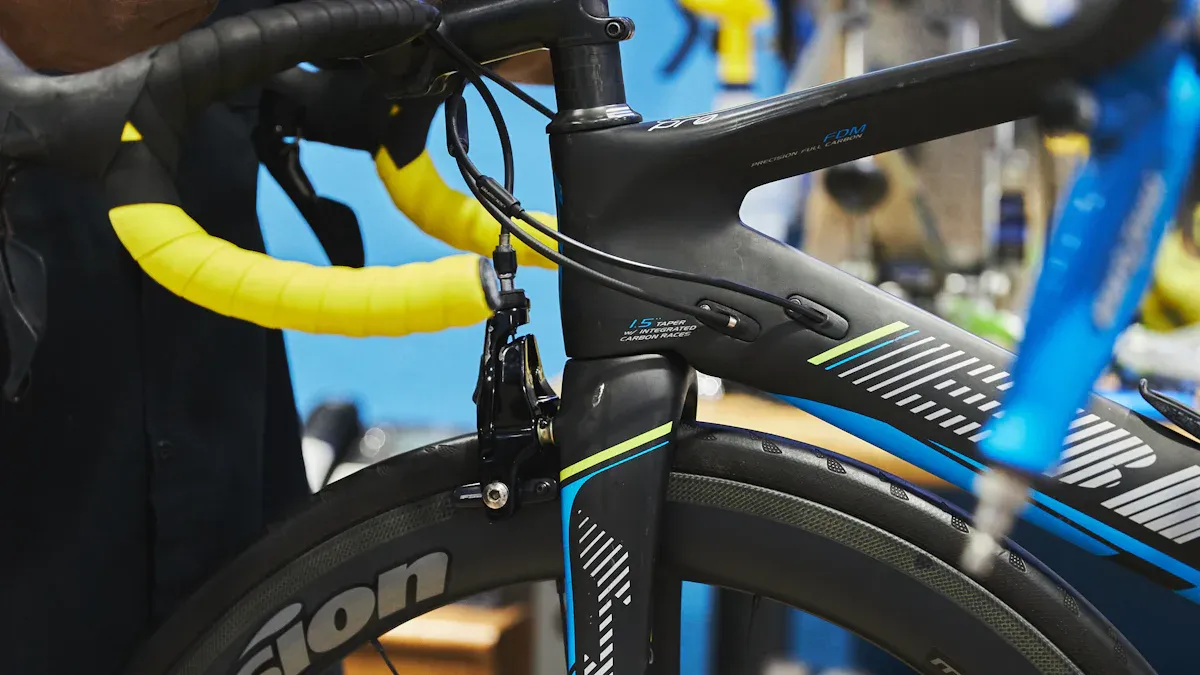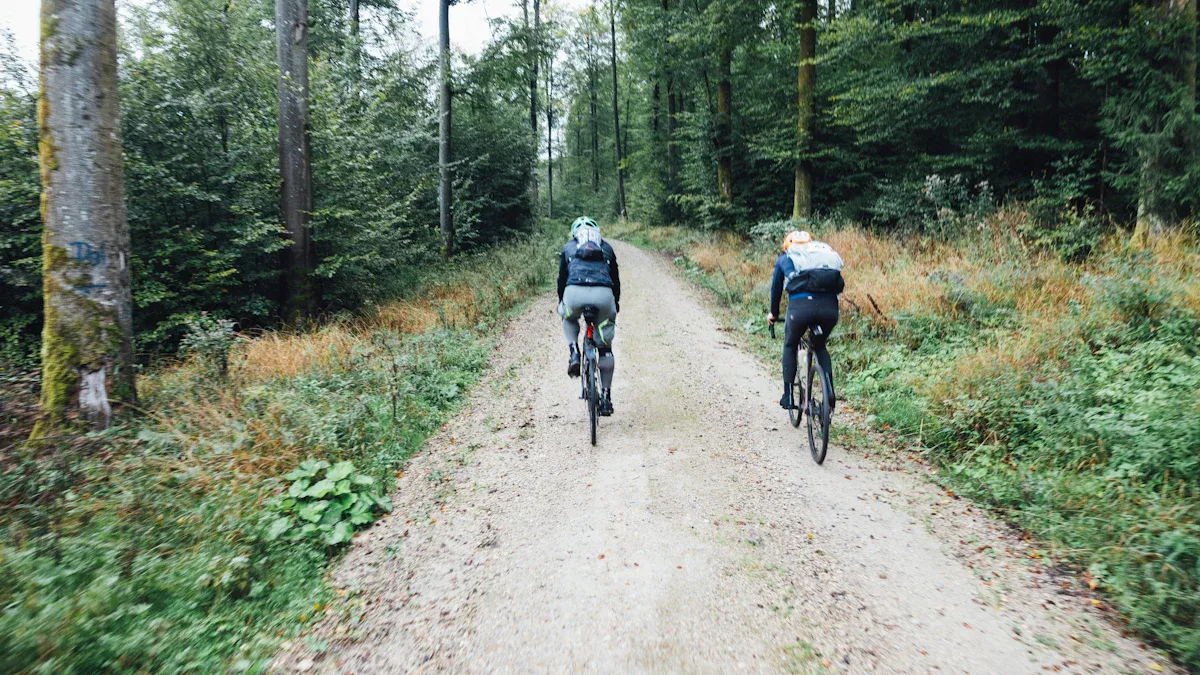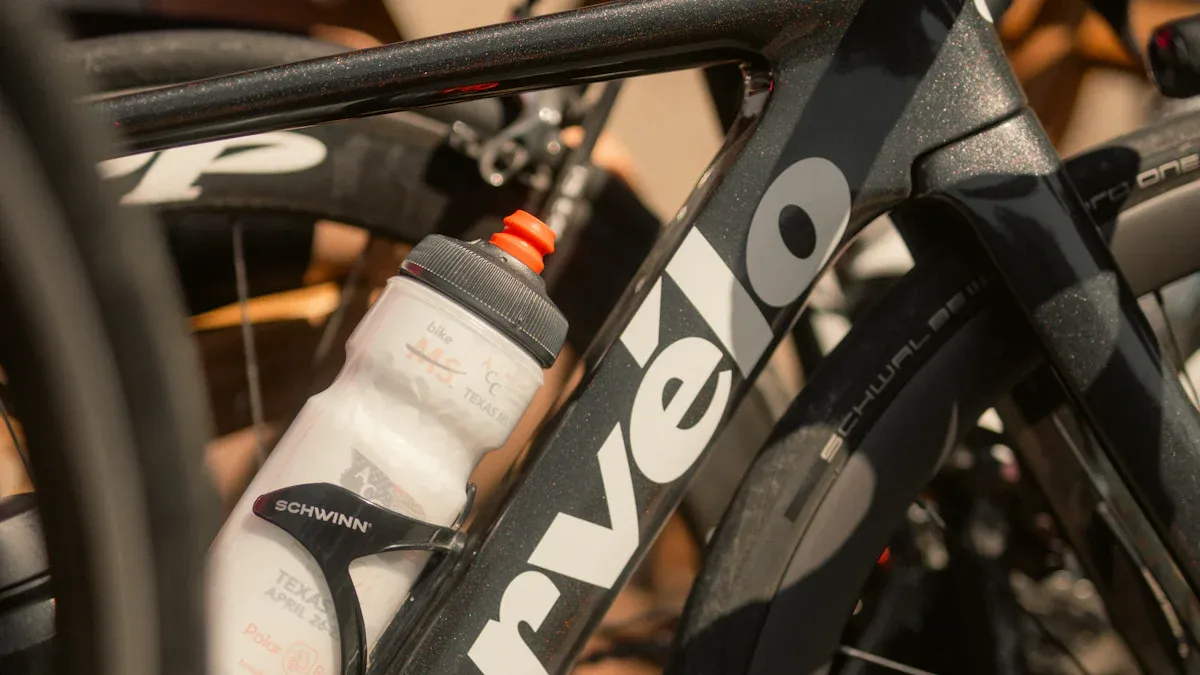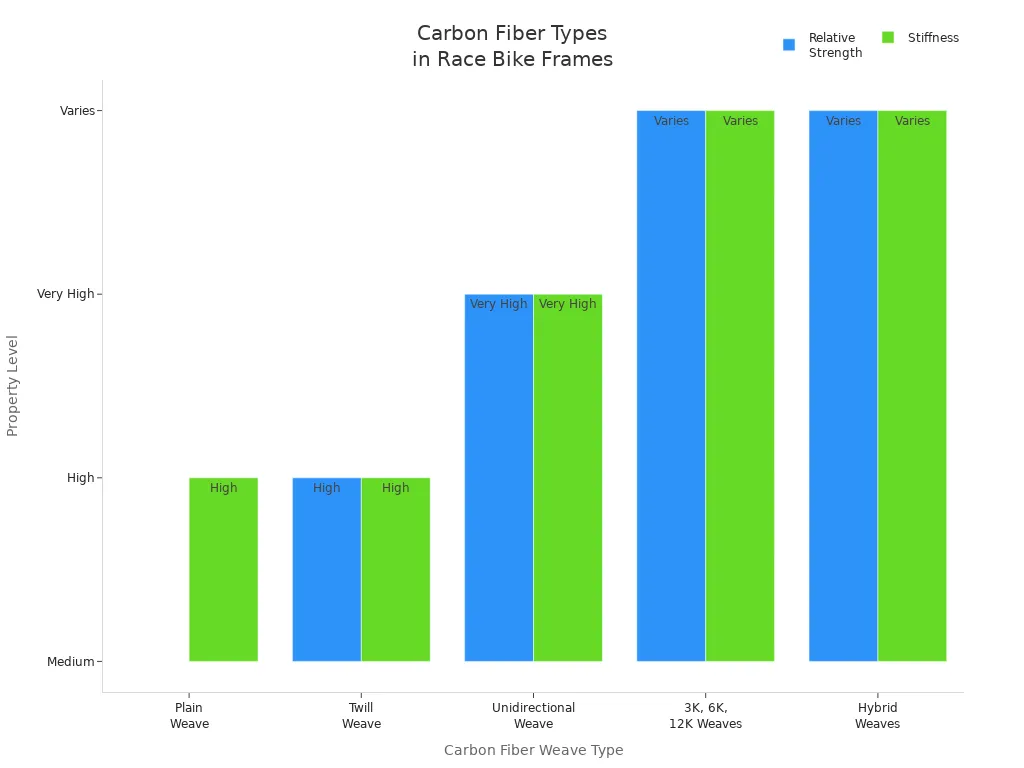
When you compare a carbon race bike frame, always start with your goals and riding style. The right carbon fiber bike frame can boost both your performance and comfort. Think about how to choose a road bike that matches your needs. Focus on frame comparison, carbon fiber road bike quality, fit, and compatibility. Your goals and the way you ride help you find the right road bike. Many riders ask how to choose a road bike that suits them, so keep these points in mind when you look for a carbon fiber road bike.
Key Takeaways
Pick a carbon race bike frame that fits how you ride and what you want to do. This helps you go faster and feel more comfortable. – Look for things like weight, stiffness, aerodynamics, and how well the frame absorbs bumps. These features make your ride better. – Make sure the frame fits you by measuring your body and trying different frames. A good fit stops pain and helps you ride better. – Check if the frame works with your brakes, wheels, and drivetrain. This keeps your ride safe and smooth. – Think about how much money you want to spend and what features you need. A carbon frame that is cared for can last about 10 years and keep its value.
Riding Style and Goals

Race, Endurance, or All-Round
You should think about what you want from your bike. There are different types of road bikes for different needs. Some people want to race. Some want to ride far. Others want a bike that can do many things. The table below shows how your riding style affects the frame you pick:
Riding Style | Frame Geometry Characteristics | Influence on Frame Selection |
|---|---|---|
Road Bikes | Aggressive geometry, lower handlebar position | Pick these for speed and good energy use; they are light and stiff |
Mountain Bikes | Upright geometry for stability on rough terrain | These are strong and give more comfort and control |
Hybrid Bikes | Combination of road and mountain geometries | These are good for both comfort and performance |
Touring Bikes | Relaxed geometry with mounting points | These are made for comfort and long trips |
If you want to race, look for a frame with a sharp shape and low handlebars. This helps you go faster and use your energy better. If you want to ride for a long time, pick a frame with a relaxed shape. It will help you feel better on long rides.
Performance vs. Comfort
Your goals are important when you choose a frame. Racing frames have shapes that cut through the wind. They use short forks and stiff carbon to help you go fast. These frames have sharp angles and flat tubes. Endurance frames are made for comfort. They have longer wheelbases and rounder tubes. They also have parts that help soak up bumps. These features help you feel less tired on long rides.
Racing frames use unidirectional carbon to be light and stiff.
Endurance frames use woven carbon to help with bumps.
Racing bikes have lower handlebars and longer top tubes.
Endurance bikes have higher handlebars and shorter top tubes.
Tip: Think about how you ride most of the time. Pick a bike that fits your main riding style.
Frame Features
Weight and Stiffness
Weight and stiffness change how your bike feels. A lighter frame helps you climb hills faster. It also makes your bike easier to control. Most medium carbon fiber road bike frames weigh between 600 and 1100 grams. The weight depends on the carbon type and if the frame is painted or raw.
Carbon Fiber Type | Frame Size | Weight Range (Raw Frame, grams) | Weight Range (Painted Frame, grams) |
|---|---|---|---|
High Modulus (HM) | Medium | 600 – 800 | 700 – 900 |
Intermediate Modulus (IM) | Medium | 700 – 900 | 800 – 1000 |
Standard Modulus (SM) | Medium | 800 – 1100 | 900 – 1200 |
Stiffness is just as important as weight. A stiff frame lets you push more power to the wheels. This helps you go faster and waste less energy. Some bikes use special carbon layups to keep the frame stiff near the chainstays and bottom bracket. This design helps you pedal harder without losing speed. Stiff frames make your ride more efficient. But if a frame is too stiff, it can feel rough.
Note: If you weigh more, pick a bike with high-strength carbon or reinforced frame materials. These frames handle more force and last longer.
Aerodynamics and Vibration Absorption
Aero features help you move through the wind faster. Carbon fiber road bike frames often have aero-shaped tubes. These include the head tube, seat post, down tube, and fork. Aero shapes lower drag and help you keep a fast position. Even handlebars and seat posts can have aero designs.
Aero frames matter most for racing or high-speed rides. The right aero frame saves energy and helps you stay with fast groups. Many light road bike frames now mix aero shapes with low weight. This gives you speed and easy handling.
Vibration absorption is another key feature. Carbon fiber frames soak up road bumps. This makes your ride smoother and more comfortable. You stay fresh on long rides and get less tired. The table below shows how carbon fiber frames compare to aluminum frames for vibration absorption and comfort:
Aspect | Carbon Fiber Frames | Aluminum Frames |
|---|---|---|
Vibration Absorption | Naturally dampens vibrations, creating a smoother and more comfortable ride. | Transmits more road vibration, potentially increasing rider fatigue over long rides. |
Design Features | Engineered for vertical compliance (comfort) while maintaining lateral stiffness (efficiency). | Less vibration dampening, though design improvements can mitigate this. |
Impact on Rider Fatigue | Reduces fatigue on long-distance rides by minimizing energy lost to vibrations. | May increase fatigue due to higher vibration transmission. |
Suitability for Long-Distance | Highly recommended for extended touring due to vibration dampening and weight savings improving endurance. | Less ideal for long-distance touring but can be improved with design choices. |
Carbon fiber road bikes help you feel fewer bumps. You can ride longer without getting tired. The frame stays stiff from side to side for good power transfer. It flexes up and down to soak up shocks.
Durability and Safety
Durability and safety are important when picking a carbon fiber bike frame. Modern frames use strong materials and smart designs. High-quality carbon fiber bikes resist cracks and damage better than older ones. Some frames use extra layers of carbon or mix in other materials to make them stronger.
If you weigh more or ride on rough roads, choose a frame with reinforced areas or thicker tubes. These features help the frame last longer and keep you safe. Always check your frame for damage after a crash or hard hit. Even the best frames need regular checks to stay safe.
Tip: Pick a carbon fiber road bike frame that matches your weight and riding style. A strong frame helps you feel safe and confident every time you ride.
Carbon Grades and Construction

Types of Carbon Fiber
When you look at carbon fiber road bike frames, you see different grades and weaves. High modulus carbon fiber is very stiff. It helps you push harder and go faster. But it can feel rough on bumpy roads. Standard modulus carbon fiber is softer. It gives you more comfort and a smoother ride. This is good for long trips. The grade you pick changes how your bike feels. It affects weight, stiffness, and comfort.
Carbon fiber comes in different weave patterns. Each pattern makes the frame act in a special way. Here is a table that shows the main types:
Type of Carbon Fiber Weave | Description | Properties | Use in Race Bike Frames |
|---|---|---|---|
Plain Weave | Over-under pattern | Equal strength, lightweight, good stiffness | Balanced performance |
Twill Weave | Diagonal pattern | Strong, stylish, great strength-to-weight | High-end frames |
Unidirectional (UD) Weave | Fibers in one direction | Maximum strength and stiffness | Reinforcing key areas |
3K, 6K, 12K Weaves | Bundled fibers | Thicker weave means more strength | Chosen for strength and weight balance |
Hybrid Weaves | Mixed patterns | Optimizes looks, strength, and stiffness | Tailored for specific needs |

Tip: If you want a bike for racing, pick high modulus and unidirectional weaves. For comfort, choose standard modulus and twill or plain weaves.
Construction Methods
It is important to know how carbon fiber bikes are made. The way the frame is built changes how strong and light it is. Most carbon fiber road bike frames use monocoque construction. This means the frame is made as one piece in a mold. The frame is hollow, strong, and light.
Some frames use tube-to-tube or lugged construction. Builders join tubes together. This lets you change the frame shape. Braided construction uses woven carbon strands around a form. Then the frame is cured to make it hard. Each method uses layers of carbon fiber set in different ways. This helps the frame soak up bumps and stop cracks.
High-end frames use many pieces of carbon fiber with resin.
A bladder inside the frame helps make smooth joins and strong parts.
Tube-to-tube and lugged frames can be shaped and fixed easily.
Good alignment and checks keep your frame safe and strong.
Aero shapes and special materials make the price go up. You pay more for better speed, less weight, and smoother rides. Carbon fiber bikes cost more than aluminum because of these features.
Note: Check your bike often and use it carefully. If you see cracks, stop riding and get your frame checked.
Fit and Sizing for the Right Carbon Race Bike Frame
Measuring for the Right Road Bike
Getting the right fit is the most important step when you choose a carbon race bike frame. A bike that fits you well helps you ride longer, faster, and with less pain. You need to measure your body and match it to the frame. Start by measuring your inseam. Stand on a flat floor with your feet apart. Place a book or ruler against your crotch and measure from the top of the book to the floor. This number helps you find the right stand-over height and saddle height.
Use the size charts from bike makers as a starting point. Match your height and inseam to the chart. Remember, these charts can change from brand to brand. You should also look at the contact points on the bike. These are the pedals, saddle, and handlebars. Check the saddle height and the reach to the handlebars. The top tube length is very important. It shows how far you stretch between the seat and the bars. Stack and reach measurements help you fine-tune your fit. Try different frames if you can. Pay attention to how your body feels and how easy it is to control the bike.
Tip: Riders with the same height can have different leg and arm lengths. Always measure yourself and test ride before you buy.
A good fit means you sit in a balanced position. You use less energy and feel less strain. Studies show that correct frame sizing and geometry, like top tube length and stack height, help you stay comfortable and pedal efficiently. The right road bike should match your body and riding style.
Geometry and Stand-Over Height
Frame geometry shapes how your bike handles and how you feel on the ride. Road bike geometries include many parts, such as head tube angle, wheelbase, and chainstay length. Each part changes how the bike turns, how stable it feels, and how you sit on it.
Here is a table that shows how geometry affects handling and stability:
Frame Geometry Parameter | Impact on Handling and Stability |
|---|---|
Head Tube Angle | Steeper angle gives quicker steering; slacker angle improves stability. |
Fork Trail (Rake) | More rake lowers trail, making steering less stable. |
Wheelbase | Shorter wheelbase makes steering faster; longer wheelbase adds stability. |
Stem Length | Shorter stem gives quicker steering; longer stem adds stability. |
Handlebar Width | Narrow bars make steering quicker; wide bars give more control. |
Chainstay Length | Longer chainstay adds stability and comfort; shorter chainstay makes the bike more agile. |
Bottom Bracket Drop | Larger drop lowers your center of gravity, making the bike stable. |
Seat Tube Angle | Changes how you pedal and sit, which affects control. |
Stand-over height is another key part of fit and safety. You need enough space between the top tube and your body when you stand over the bike. Experts say you should have at least 1-2 inches of clearance. This space lets you get on and off the bike easily and helps you stop quickly. If the clearance is too small, you risk injury. If it is too big, you may lose control or feel tired.
Frame design and tire size can change stand-over height. Sloping frames and step-through frames make it easier to mount and dismount. Bigger tires raise the stand-over height. For heavier bikes, like eBikes, you need at least 2 cm (0.8 inches) of clearance for safety.
Note: Always check stand-over height before you buy. A good fit keeps you safe and comfortable.
Why Professional Bike Fitting Matters
You can measure and test frames yourself, but expert bike fitting services give you the best results. Mass-produced frames often use standard sizes and shapes. These may not fit your body perfectly. A professional fitting service looks at your body, riding style, and goals. The fitter can adjust the frame geometry and components, like stem length and saddle position, just for you.
Here are the steps a professional fitting service uses to improve your ride:
The fitter measures your body and checks your riding position.
The fitter adjusts the frame geometry, such as bottom bracket drop and chainstay length, to match your needs.
The fitter sets up the handlebars, stem, and saddle for comfort and control.
The fitter helps you pick a custom frame if needed, so you avoid common problems with mass-produced bikes.
The fitter checks your Q-factor, which is the distance between your pedals. A good Q-factor matches your natural stance and helps you pedal efficiently.
The fitter makes sure your bike fits your riding style, whether you race, ride long distances, or want all-around performance.
A professional fitting makes your bike feel better, ride smoother, and last longer. You get more comfort, better performance, and more confidence on every ride.
Tip: If you want the best fit, visit a bike shop with expert fitting services. A custom fit can transform your riding experience.
Compatibility and Budget When You Choose a Road Bike
Drivetrain, Wheels, and Brakes
When you look at carbon race bike frames, you need to check if the frame matches your drivetrain, wheels, and brakes. You want every part to fit together. If you use disc brakes, the frame must have special mounts for them. These mounts help you install the brakes safely. Thru-axles work with disc brakes and make your wheels line up better. This gives you more control and makes your bike stiffer. You also get better braking and handling.
Frames with disc brakes let you use wider tires. Wider tires help you ride on rough roads and give you more comfort.
Disc brake frames often have internal cable routing. This makes your bike look clean and helps with aerodynamics.
You need to match your wheels to your brake system. Disc brake wheels work best with disc brake frames.
If you want to know how to choose a road bike, always check if the frame fits your favorite wheels and brakes.
Disc Brake and Component Compatibility
Disc brakes give you strong and steady stopping power. You can brake safely in rain or on steep hills. You control your speed better and avoid wheel lock-up. Disc brakes also spread heat, so your brakes work well on long rides. You can use wider tires, which help with grip and comfort. Disc brakes do not wear down your rims, so your wheels last longer.
Disc brakes work even if your wheels are not perfect.
You change brake pads easily and do not need to fix them often.
Frames with disc brakes cost more, but you get better safety and control.
You need to check if all your parts fit your frame. Use the right torque for bolts. Carbon assembly paste helps protect your frame. Get your bike checked by a pro every year. Make sure your forks, wheels, and seat posts match your frame. If you use the wrong parts or tighten bolts too much, you can damage your frame. Hidden damage can cost a lot to fix.
Price and Value
Carbon race bike frames can cost a lot. Some top frames cost over $5,000. The price depends on the carbon grade, brake system, and design. You pay more for frames with disc brakes and advanced features. A good carbon frame lasts about 10 years if you take care of it. You need to clean it, protect it from the sun, and avoid crashes. Some brands offer a warranty, which helps keep resale value high.
Aspect | Details |
|---|---|
Cost of premium carbon bike | Can exceed $16,000, with about one-third for the frame |
Expected lifespan | Around 10 years with regular upkeep |
Maintenance frequency | Inspections every 5,000-7,000 miles |
Repair costs | Minor damage repairs cost between $300-$800 |
Durability improvements | Modern frames endure higher impacts and resist UV better |
Resale value factors | Warranties and repairability help keep value |
When you choose a road bike, balance cost, performance, and long-term value. A frame that fits your needs and matches your parts saves money and gives you a better ride.
When you look at carbon race bike frames, think about fit and comfort. Notice how the bike feels when you ride it. Look at the table to see how carbon frames and aluminum frames are not the same:
Factor | Carbon Fiber Frames | Aluminum Frames |
|---|---|---|
Weight | Lighter | Heavier |
Ride Feel | Smoother, less vibration | Firmer, more vibration |
Try riding different bikes to see which frame works best for you. The right carbon race bike frame helps you go faster. It makes your ride feel better and helps you feel sure of yourself every time you ride.
FAQ
What is the main benefit of a carbon race bike frame?
You get a lighter bike that feels fast and easy to handle. Carbon frames also absorb road bumps better than metal frames. This helps you ride longer and stay comfortable.
How do I know if a carbon frame fits me?
Check the size chart from the bike brand. Measure your height and inseam. Test ride if you can. You should feel balanced and reach the handlebars without stretching.
Tip: A professional bike fitting helps you find the perfect size.
Can heavier riders use carbon race bike frames?
Yes, you can use a carbon frame if you weigh more. Look for frames with reinforced areas or high-strength carbon. These frames support extra weight and last longer.
Rider Weight | Frame Suggestion |
|---|---|
Under 200 lbs | Standard carbon frame |
Over 200 lbs | Reinforced carbon frame |
How do I care for my carbon bike frame?
Clean your frame with mild soap and water. Check for cracks or chips after every ride. Store your bike indoors. Use a torque wrench when tightening bolts to avoid damage.
Note: Regular checks keep your frame safe and strong.
See Also
Key Factors To Consider When Comparing Bike Frame Sizes
Professional Tips For Selecting The Perfect Carbon Mountain Frame
Step-By-Step Guide To Measuring Bike Frames For Comfort
